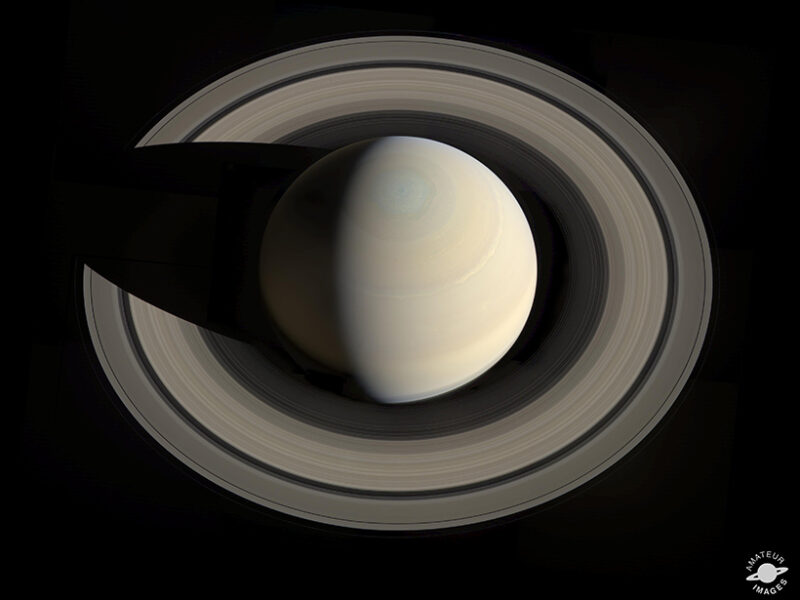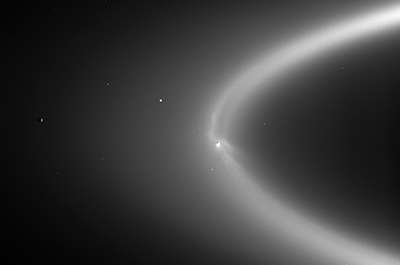
NASA image of Cassini spacecraft between Saturn and innermost ring, from April this year. This mission is now on its last legs but has been an unqualified success.
Barely hours ago NASA's Cassini spacecraft completed its death plunge into Saturn's atmosphere , ending its 20-year mission to explore one of the solar system's most intriguing outer planets. It also ended one of the most productive space missions in NASA history. Confirmation of Cassini's demise came at about 11:55 GMT when radio signals from the spacecraft came to an abrupt halt. We believe the density of the atmosphere caused the spacecraft to tumble and sever its radio link. Soon after, friction with the atmosphere would have caused Cassini to burn up and disintegrate.
Note that the crashing of Cassini was deliberate, planned by NASA to avoid the craft randomly colliding into fragile Saturnian objects, small moons - contaminating them. The craft was headed for radio signal death anyway and its orbit would have degraded, this was a way to speed its demise. Call it an "assisted suicide".
Months earlier, barely a day before April 28th this year, we learned the Cassini spacecraft had survived an unprecedented perilous trip between Saturn and its rings, and had amazing pictures to show for it. NASA flight controllers regained contact with Cassini a day after it became the first craft to cross this hazardous region. (The rings themselves are made up of countless icy particles, any of which could have smacked Cassini.) The spacecraft’s big dish antenna served as a shield as it hurtled through the narrow gap, temporarily cutting off communications.
Now, almost four and a half months later, we appreciate more fully the scale of the monumental success for the Cassini-Huygens mission to Saturn. This even as the craft has plunged into the atmosphere of Saturn on a pre-set death dive. The exquisitely crafted plan had always been that Cassini would transmit data to Earth to the very end, dispatching reams of data and photo images as the finale to one of NASA’s greatest missions.
Up to its fiery end the little craft more than fulfilled its mission goals and then some. It sent back stunning images (see link at bottom for many) and troves of scientific data. It has discovered moons, and geysers spewing from the weird Saturn satellite Enceladus. It landed a probe on the moon Titan. Below I will list the ten most notable accomplishments.
How did the flight controllers ever manage to 'thread the needle' between the rings? Basically using lots of math, including partial differential equations and dynamic matrices. Asked two weeks ago for some insights, navigation team member Mar Vaquero pointed to a complex set of equations on a whiteboard in her workspace at the lab as she explained thusly (in a Denver Post Aug. 28 cover story):
"So you use math. You have matrices. And you have partials. Those are changes in your trajectories with respect to each parameter. So you use your matrices, your vectors, position and velocity and your partials to come up with this delta V that you see here.”
Delta V, of course, would be the change in velocity.

Image of Saturn looking down at its N. pole based on integrating twelve different images fomr Cassini using different filters. (NASA/JPL-Caltech/Space Science Institute/G. Ugarkovic)
Technically speaking it's not the "Cassini mission" but the "Cassini-Huygens" mission. The Europeans designed the Huygens probe, a separate vehicle that detached from Cassini when it passed close to Titan.
After Cassini, launched in 1997, arrived at Saturn in 2004, Huygens disengaged from the main spacecraft and dropped through Titan’s thick clouds. It sent back details of an alien world that possesses a stew of complex organic molecules, including liquid methane. Hydrocarbons rain from the sky. There are lakes and rivers. It’s the only place in the solar system other than Earth known to have rain and open bodies of liquid on the surface.
Cassini also discovered something amazing about Saturn’s moon Enceladus: It has geysers spewing from its south pole. Almost certainly it has an interior ocean, sealed beneath ice, that contains great volumes of water and possibly hydrothermal vents.
So what are the five most notable finds of Cassini-Huygens?
1. The craft revealed Enceladus' potentially habitable internal ocean.
Mission scientists in July, 2006, sent the craft on a flyby of Enceladus' ice-covered south pole gouged with deep crevasses, orbits within Saturn’s magnetic field. But the magnetic field acted strangely around Enceladus, responding to the moon somewhat akin to how magnetic fields act around bodies with thin atmospheres. So researchers sent Cassini to look for that presumed atmosphere. What they found changed almost the entire focus of the mission. During that flyby, instruments detected water vapor and ice grains.
On subsequent flybys, scientists found that Enceladus’s ice shell encloses a global ocean. By sending the spacecraft through the fountains again and again, researchers detected sodium, water vapor, and organic molecules composed of oxygen, nitrogen, carbon, and hydrogen—molecules thought to be important for life.
2. The craft revealed Titan to be a potentially primordial earthlike world
When Voyager passed by the Saturn system, it sent back images of Saturn’s largest moon, Titan, covered in a thick, yellowy haze. On 24 December 2004, the saucer-shaped craft popped off Cassini and careened toward Titan. Several weeks later, on 14 January 2005, Huygens parachuted onto Titan’s surface. Throughout the 2.5-hour journey, Huygens gathered the first in situ data about Titan’s atmosphere and sent humanity the first pictures of the moon’s surface. Mission scientists took those images and stitched together this video:
Cassini has flown by Titan more than 100 times since 2005. The flybys showed that Titan is more complex than anyone imagined revealed that Titan’s atmosphere holds heavy, carbon- and hydrogen-rich complex ions, thought to be precursors of life. Dunes of electrified hydrocarbon sand sweep over Titan’s surface, hinting at an atmosphere whipped by wind. Storm clouds dump methane rain that may carve river channels through the frozen surface. The perspective is similar to what we believe applied to the primitive Earth,
. 3. Cassini changed how we conceive 'habitability'.
The Cassini-Huygens mission’s observations of Enceladus and Titan marked one of the mission’s most profound legacies: a tectonic shift in how we think of “habitability.” Before Cassini-Huygens, when scientists pondered life beyond Earth, they imagined searching terrestrial planets like Mars or Venus, orbiting close enough to the Sun where liquid water could pool on a rocky surface. But Venus turned out to be a hell hole with a runaway greenhouse gas effect, and Mars so far turned out to be barren and hostile with monster dust storms.
Cassini-Huygens changed the game when it found complex hydrocarbons on Saturn’s ocean moons, hinted at hydrothermal vents on Enceladus, and revealed a cycle of liquid methane on Titan. The bottom line is, ocean worlds encapsulated by ice are now more propitious targets in the broader search for life beyond Earth.
4. Cassini found Enceladus ocean material in Saturn's E-Ring.

Enceladus orbits Saturn within this ring. In fact, Enceladus orbits in the densest part of this ring. Once the Cassini team discovered Enceladus’s geyserlike plumes in 2005, they wondered, Could particles from Enceladus’s plumes be bulking up the E ring?
Analyzing icy tendrils of particles jetting out of Enceladus and comparing those particles to E ring particles answered this question: Yes, some of the plume material does indeed leave the moon fast enough to populate the ring, rather than falling back onto Enceladus’s surface.
5. Cassini revealed one of Saturn's infrequent storms which helped detect atmospheric water.
When Voyager flew by Saturn, it detected lightning, but researchers were unsure of where the lightning signature came from. Cassini’s instruments showed the storms “rising and setting over the horizon” as the planet turned, confirming that the lightning came from Saturn’s atmosphere,
In 2010, a large white spot formed, signaling a storm. The storm stretched 10,000 kilometers across, about the size of Earth. The planet’s rotation dragged this storm along until it became a band streaking across the planet, widening north to south to span 15,000 kilometers.
Over the next several months, as Saturn rotated, the storm continued to drag around the planet like a ribbon, covering 5 billion square kilometers, until one day the tail of the storm collided with the head of the storm and they annihilated each other. This massive storm also showed that water exists in a lower layer of Saturn’s atmosphere.
Now, all that has ended with the deliberate crashing of Cassini but it's legacy is established for space mavens and buffs.
See also:
https://www.nasa.gov/image-feature/jpl/pia21625/highlighting-titans-hazes
In 2010, a large white spot formed, signaling a storm. The storm stretched 10,000 kilometers across, about the size of Earth. The planet’s rotation dragged this storm along until it became a band streaking across the planet, widening north to south to span 15,000 kilometers.
Over the next several months, as Saturn rotated, the storm continued to drag around the planet like a ribbon, covering 5 billion square kilometers, until one day the tail of the storm collided with the head of the storm and they annihilated each other. This massive storm also showed that water exists in a lower layer of Saturn’s atmosphere.
Now, all that has ended with the deliberate crashing of Cassini but it's legacy is established for space mavens and buffs.
See also:
https://www.nasa.gov/image-feature/jpl/pia21625/highlighting-titans-hazes
No comments:
Post a Comment